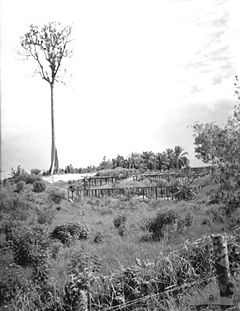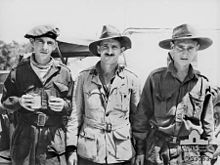Sandakan's death marches

The Sandakan Death Marches ( Engl. Sandakan Death Marches , Jap. サンダカン死の行進 , Sandakan shi no Koshin ) were a series of forced marches in British North Borneo during the Pacific War in 1945 in which more than one thousand Allied prisoners died by the Japanese Empire in Sandakan camp had been interned. The marches led from Sandakan to Ranau . Only six Australians survived the end of the war and managed to escape during the march to Ranau.
The prisoners of war were used to build the Sandakan military airfield . During the course of the captivity, the Japanese army carried out several of the death marches. At the end of the war, the last of the prisoners of war were killed to prevent them from giving evidence about the crimes of the guards. Six Australian soldiers managed to survive fleeing. They were supported by the population. The survivors witnessed the war crimes tribunals in Tokyo and Rabaul . They were eyewitnesses to the crimes and atrocities of war. Several officers in charge of the Imperial Japanese Army , including Lieutenant General Baba Masao , Captain Hoshijimi Susuma, Captain Takakuwa Takuo and Captain Watanabe Genzō, were found guilty of war crimes and sentenced to death .
A memorial for the victims in Sandakan and Ranau was established in Kundasang , Sabah in 1962.
The Australian composer Jonathan Mills created a lament in memory of a dead person for the Sandakan Death Marches in 2004. His father survived a period of imprisonment in Sandakan from 1942 to 1943.
First death march
When the Japanese became increasingly on the defensive in the further course of the war, the airfield in Sandakan was also the target of constant bombing by the Allies from October 1944. In January 1945 the damage was so great that repairing the runway was out of the question. On January 10, 1945, work was completely stopped. Also in January 1945, the camp inmates were informed that around 455 prisoners of war were being transferred to another part of Borneo, where there was more to eat. In a total of nine groups of around 50 men each, these men left the camp between January 28 and February 6. While Groups 1 to 5 marched through to Ranau, the men in Groups 6 to 9 set up a makeshift camp in the village of Paginatan for a month because there was not enough space in the camp in Ranau for so many prisoners of war. In Kampung Paginatan, about 42 kilometers from Ranau, the Japanese maintained a food depot. The 138 prisoners of war in Groups 6 to 9 were now forced to transport sacks of rice between Paginatan and Ranau. Many died of exhaustion, and by the time the men were finally transferred to Ranau at the end of the month, only 46 were alive.
The POWs were quartered in dirty and overcrowded huts under the most dire conditions. Dysentery , beriberi and malaria gradually dragged the men away. Those who were still alive started the day with the funeral of their comrades:
" There'd be a burial party every morning ... which consisted of two men to each body. We used to wrap their wrists and ankles together and put a bamboo pole through them and carry them like a dead tiger. We had no padre. And no clothes on the bodies, just straight into six inch deep graves. The soil was too hard to dig any deeper. We'd lay the body in and the only mark of respect they got, we'd spit on the body, then cover them up. That was the soldier's way. "
“There was a funeral squad every morning ... that consisted of two men per corpse. We used to tie her wrists and ankles together, stick a bamboo stick through them, and then carry her like a dead tiger. We didn't have a priest. And no clothes for the dead, just into the 15 cm deep pits. The ground was too hard to dig any deeper. We put the body in there and the only respect we could show them was to spit on their bodies and then bury them. That was the way of the soldiers. "
On June 26, less than five months after leaving the Sandakan camp, there were only six survivors, five Australians and one British soldier.
Second death march
From May 1945 an order to dissolve the prisoner of war camp was implemented. On May 17th, Captain Takakuwa Takuo took command of the camp. On May 29, 1945, he ordered the second death march of 536 prisoners of war to Ranau and had the camp area set on fire. The prisoners were driven through the jungle in groups of around 50 men under guard by Japanese soldiers. The march lasted 26 days. Only 183 of them - 142 Australian and 14 British POWs - reached the so-called " Last Camp " on June 27, 1945 in the Liwagu Valley near Ranau. To their horror, they found there that only six of the participants in the first march were still alive.
Two prisoners managed to escape during the march from Sandakan to Ranau. Gunner Owen Campell fled to the jungle with four comrades during an air raid. Campell was the only one to survive after the residents of Kampung Kulang hid and nursed him to health. The same thing happened to Richard Dick Braithwaite, a fighter-bomber, who - hidden in a canoe under banana leaves - was paddled down the Sungai Labuk by a local to Pulau Libaran , where he was picked up on June 15, 1945 on board an American patrol boat.
Among the POW in Ranau there were only a few who were reasonably strong. Convinced that it would only be a matter of time before they too died, four soldiers - Keith Botterill, Nelson Short, William Moxham and Andy Anderson - ventured on July 7th. Anderson died of dysentery, but the other three were hidden by a local named Bariga until the Japanese surrendered on August 15.
The sixth prisoner of war to escape from the camp in Ranau was William H. Sticpewich. A Japanese guard confided in him that any remaining POW should be killed. Sticpewich and Reither left the camp on July 28th. First they hid in the jungle until they were accidentally discovered by Dihil bin Ambilid, a local Christian, who took care of them. Reither died of dysentery and malnutrition, but Sticpewich survived.
Third death march
On June 10, 1945 - 30 more prisoners had meanwhile died in the Sandakan camp - the last group of 75 prisoners of war was marched towards Ranau. They were already so weak and emaciated that none of them reached Ranau. All prisoners collapsed after 50 kilometers. Anyone who remained lying was shot by the Japanese guards.
POW route
The "POW Route", on which the prisoners of war marched in the area during the three death marches, was documented in 1945 by the British and Australian military in order to bring the large number of remains along the route to a dignified burial. The route begins in Sandakan and ends at the " Last Camp " near Ranau. The stations of the route are marked with a sign in the area.
See also
- Japanese invasion of Southeast Asia
- Sandakan Memorial Park
- Kundasang War Memorial
- Quailey's Hill Memorial
- Last POW Camp Memorial
literature
- Richard Reid: laden, fevered, starved - The POWs of Sandakan North Borneo, 1945 ( Memento of February 13, 2014 in the Internet Archive ) (PDF; 3.0 MB), Commonwealth Department of Veterans' Affairs 1999, ISBN 0-642- 39922-0
Web links
Individual evidence
- ↑ Remembering Sandakan: 1945–1999 ( Memento of July 14, 2009 in the Internet Archive )
- ↑ Note: The correct denomination of rank in the Imperial Japanese Army is rikugun taii , 陸軍 中尉
- ↑ Excerpts from important war crimes trials ( Memento from June 4, 2011 in the Internet Archive )
- ↑ War Criminals Executed At Rabaul , The Argus (Melbourne, Vic .: 1848–1954), Monday, April 8, 1946 edition
- ↑ Kundasang War Memorial ( Memento from August 16, 2013 in the Internet Archive )
- ^ Richard Reid, pp. 22-27
- ↑ a b Ooi Keat Gin: The Japanese Occupation of Borneo , page 96, Routledge, 2011, ISBN 0-203-85054-8
- ↑ Lynette Silver: The Sandaken-Ranau death marches ; Accessed January 19, 2013
- ^ Richard Reid, pp. 29/30
- ↑ Richard Reid: laden, fevered, starved - The POWs of Sandakan North Borneo, 1945 ( Memento of February 13, 2014 in the Internet Archive ) p. 31
- ↑ Ooi Keat Gin, page 97

